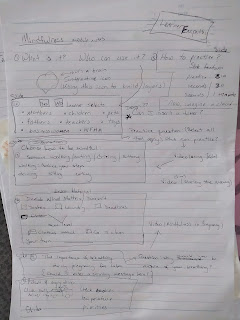Design Journal 2
Week 4:
Fleeting Thoughts...
According to Kelley & Kelley (2013) in "Move Part 1," one way to expand on a great idea is by remembering it in the first place.
They recommend one way to increase a person's creative output is to have a method for keeping track of ideas. Relying on short-term memory is a rookie move.
"Your short term memory holds a thought for only fifteen to thirty seconds." (2013)
What aobut the benefits of Journaling? How could I incorporate jorunaling (a practice I engage in regularly) into design?
Mindmapping. Why is it a helpful technique for drawing ideas?
First, what is significant about "divergent" thinking? The goal is to generate innovative ideas. Expanding a thought out to its very simplest ideas can emerge many useful points.
A mindmap takes a central idea and keeps building out from it until there are no more ideas remaining.
List vs Mindmap
- A list is good for jotting down ideas and compiling them. These are good for items you already know.
- A mindmap is more suitable for idea-constructing when one wants to create divergent thinking. The mindmap is for idea generation. Think of it as a tool to get the ideas flowing. You build out and out until you've covered everything around one particular topic.
- There's no reason they can't be used together
Application of theory: Use mindmapping to analyze a dream? First, write down immediately when you wake up what you remember of the dream. Then, use Who/ What/ When/ Where/ Why/ How to generate ideas.
Design thinking: Mindmapping: Who Benefits, Why and How?
Topic of choice: Mindfulness
Using mindmapping, discuss "Mindfulness" by answering the 5W/1H questions.
Intended target audience: Working professionals, teenagers, couples, managers
Intended value of module: More control over emotions and thoughts
Reflection: I honestly think mindfulness practices can be advantageous for anyone, including children. There's really no age that awareness outside of yourself won't bring some kind of benefit. A mindulness module might be more difficult for young learners under 10 because of their attention spans, but if the application is engaging and fun there's no reason learning can't take place.
As I developed the mindmap about mindfulness I found myself getting excited about possible sections I could create in the course. For example, a "breakout" description with the picture of a brain. The student would click on different thought bubbles for more information.
What Is Thinking
Watch your thinking in action. (McKim, 1972) C
Can you observe your thoughts as you are thinking? Even as you read, your mind's voice is thinking on different levels, including seeing imagery, building the context, and defining difficult words/phrses.
- People are motivated to think more about something they care about.
- To effectively process information, we need to understand it and it should be correct.
Where does your educational ovesight occur? Does education typically encourage flexibility?
My opinion: No. Especially formal education.
When you're taught to adapt someone else's ideas and methods in exchange for a satisfactory grade, it's possible that your own creative voice becomes stunted.


Comments
Post a Comment